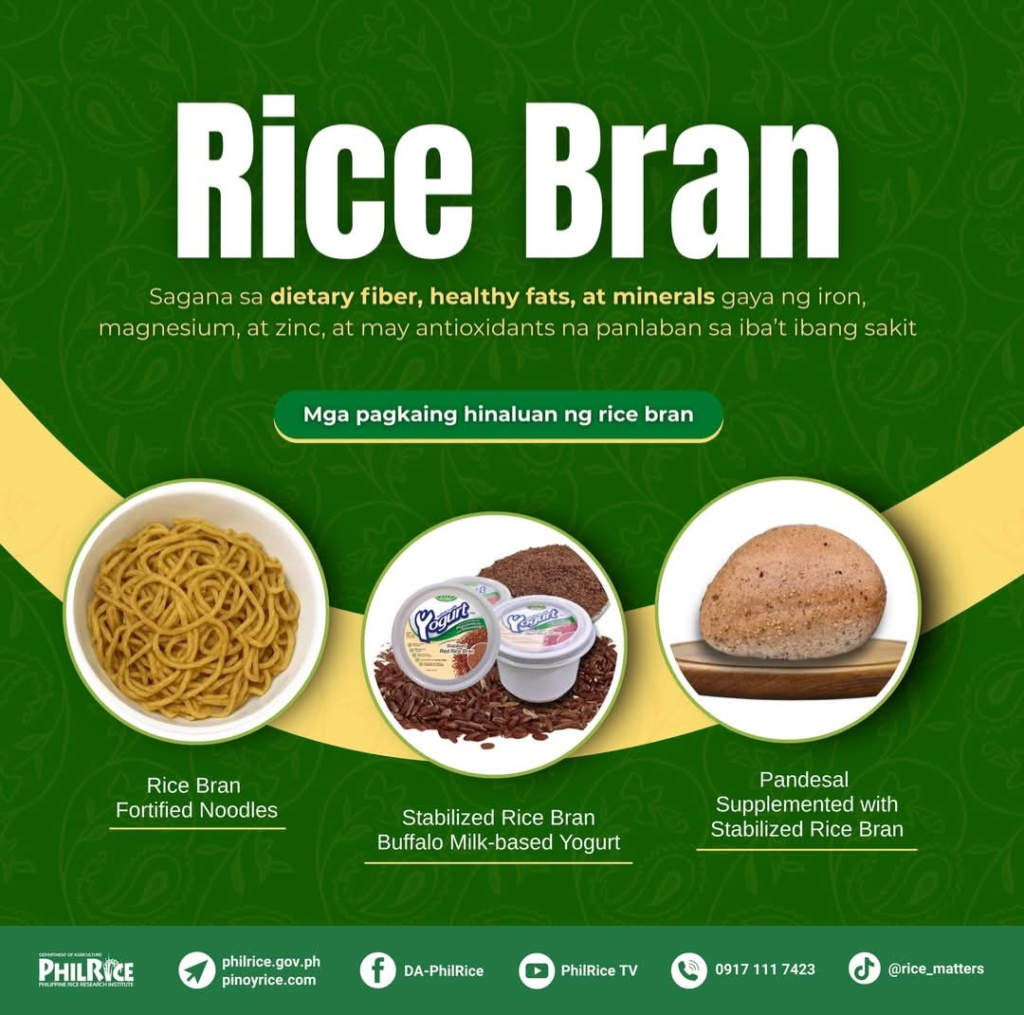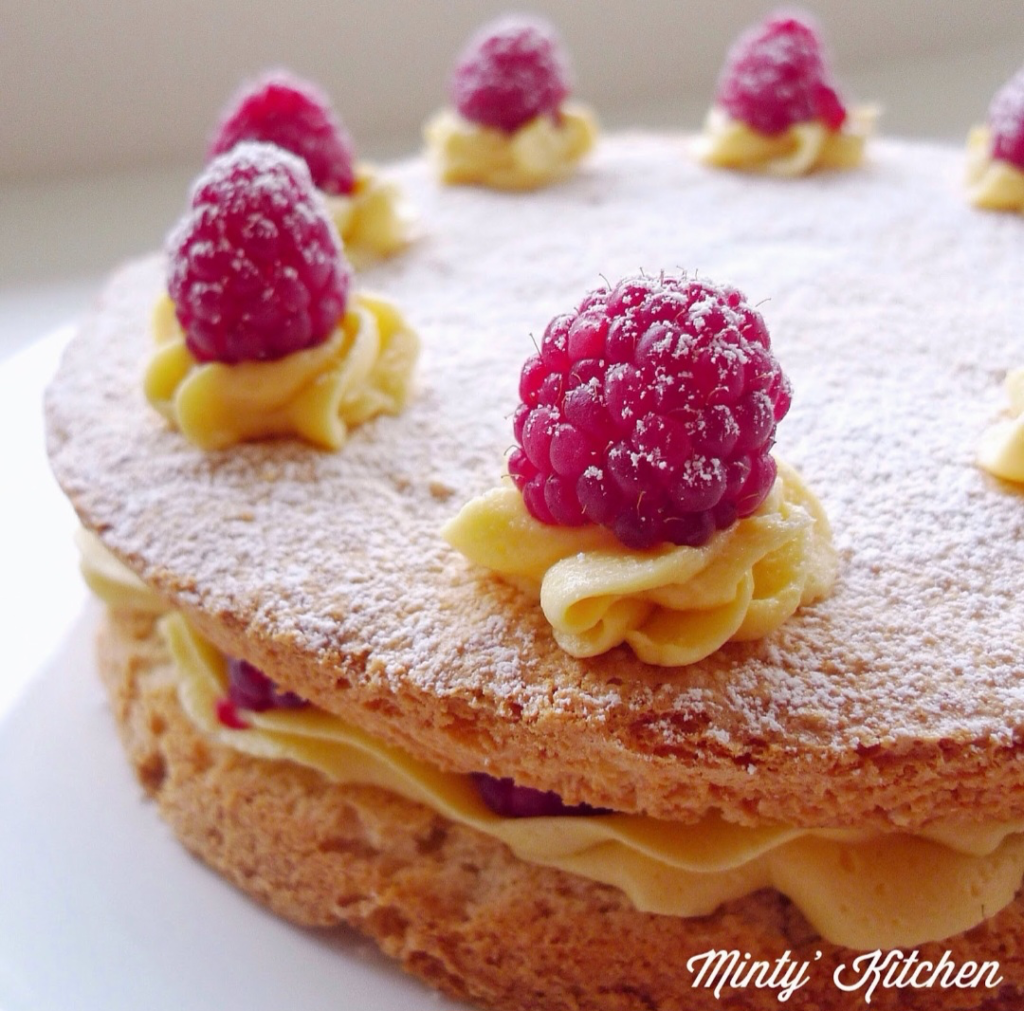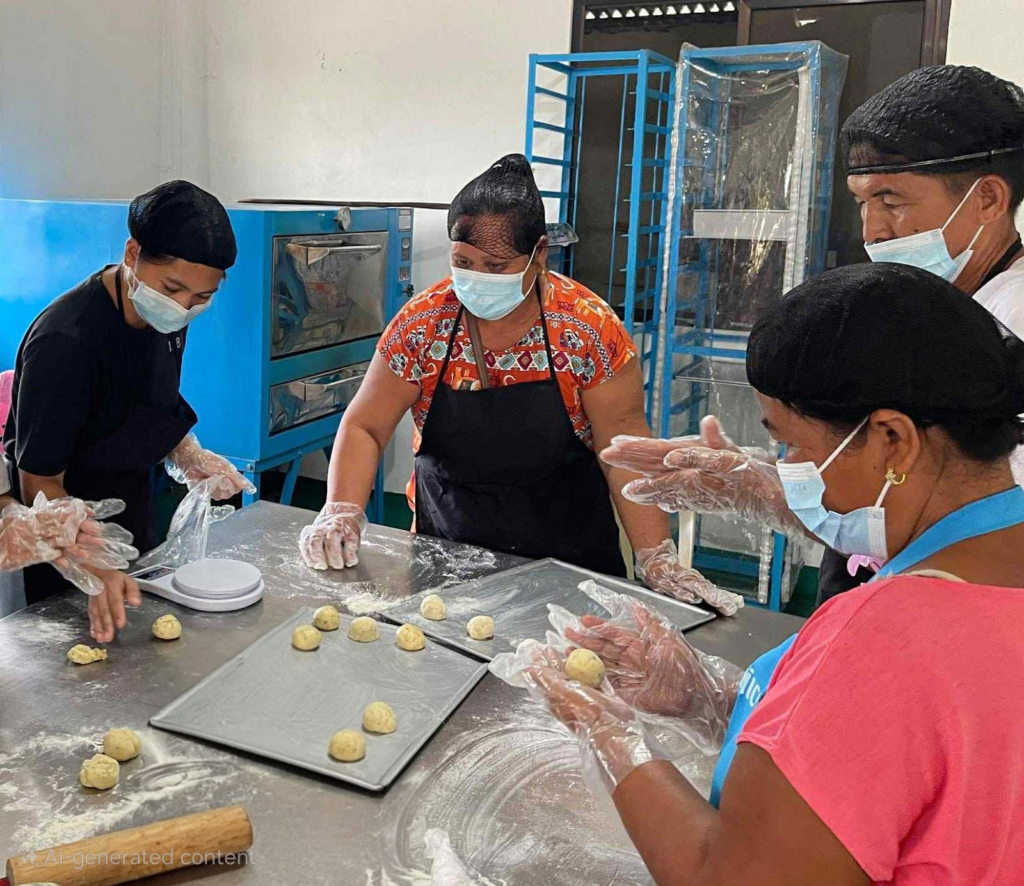Building New Value in Everyday Bread: The Case of Rice Bran Pandesal
In the Philippine bakery industry, pandesal has always been more than bread. It is a staple of every household, eaten at breakfast tables, merienda breaks, and late-night conversations. Because it is consumed daily and across all social classes, pandesal is also a natural vehicle for innovation.
Recent research from the Philippine Rice Research Institute (PhilRice)2 shows that a small change in its recipe can make a big difference in nutrition, while at the same time opening opportunities for entrepreneurs. By incorporating stabilized rice bran (SRB) into pandesal, bakers can create bread that is not only familiar and affordable but also healthier and more marketable.

Rice Bran: From By-product to Super Ingredient!Packed with fiber, healthy oils, minerals, and antioxidants, rice bran can be used to fortify everyday foods like noodles, yogurt, and pandesal. With stabilization, this humble by-product of rice milling becomes a powerhouse ingredient for healthier diets and new food innovations. Source: Philippine Rice Research Institute. (2024, September 18). Rice bran: Mga pagkaing hinaluan ng rice bran [Infographic]. Facebook. https://www.facebook.com/share/p/1KQ489unbH/
From By-product to High-Value Ingredient
Rice bran — the outer layer removed during milling — has long been regarded as a low-value by-product, often diverted to animal feeds or wasted altogether. Yet it contains rich deposits of protein, fiber, healthy oils, and antioxidants. The challenge has always been its instability: once milled, rice bran quickly turns rancid due to enzymes that break down its oil.
Textbox:
Explainer: What is Rancidity?
Rancidity happens when the natural fats in food go bad. This can be caused by:
- Air (oxidation): fats reacting with oxygen, producing a stale or “cardboard-like” smell.
- Enzymes (hydrolysis): in rice bran, a natural enzyme called lipase breaks down oils very quickly after milling. This produces free fatty acids (FFA) that make the bran taste bitter or soapy.
For bakers, rancidity means shorter shelf life, off-flavors, and wasted ingredients. This is the reason why unstabilized rice bran cannot simply be mixed into bread.
The solution is stabilization. In this case through steam heating, which makes rice bran safe and shelf-stable without losing its nutritional qualities. For bakers and food entrepreneurs, this means rice bran can move from the margins of the milling industry into the mainstream of food production. It is not just an agricultural by-product; it is an untapped ingredient for health-focused bakery products.
Textbox:
Explainer: What is Stabilized Rice Bran (SRB)?
Rice bran is the nutrient-rich outer layer of rice. It contains protein, fiber, healthy oils, and antioxidants but spoils quickly unless treated.
Stabilized Rice Bran (SRB) is rice bran that has been treated — in this study, by steam heating — to stop the enzyme that causes rancidity. This process:
- keeps rice bran safe for human food use
- extends shelf life without losing nutrients
- retains natural health benefits like fiber, vitamin E compounds (tocopherols), and γ-oryzanol (an antioxidant).
For bakers, SRB becomes a functional ingredient that can make breads healthier without sacrificing taste or texture.
Why Rice Bran Matters
According to the Philippine Statistics Authority (2024), the country produces more than 20 million metric tons of palay annually. Milling this volume generates roughly 1.2 to 1.6 million metric tons of rice bran — an amount that entrepreneurs should not ignore. When stabilized, rice bran can deliver:
- 14% protein, higher than most cereal brans
- 13% dietary fiber, which is beneficial for digestion and heart health
- 22% fat, including natural antioxidants such as oryzanol and tocopherols
Stabilization through steam heating effectively inactivates the rancidity-causing enzyme, extends shelf life, and preserves nutritional quality. The process is low-cost and accessible even to small-scale bakeries.
The Study on Pandesal
PhilRice researchers tested SRB supplementation at different levels. They found that 5% SRB was the ideal formulation.The results are highly relevant to entrepreneurs. At 5% SRB, pandesal retained its familiar look, taste, and texture, while gaining nutritional value. At this formulation, nutritional improvements included higher fiber, fat, and minerals compared to regular pandesal. Consumer acceptability was also strong. Over 90% of taste-test participants said they would buy SRB-enriched pandesal, especially when informed of its added nutrients. The research shows that functional breads can be produced using rice bran without alienating customers, provided the formulation is carefully managed.

Salt bread with 5% SRB obtained consumer acceptability comparable with control and higher than bread supplemented with 10% SRB. (Mamucod, Morales, Bulatao, Manaois, & Romero, 2024)
Textbox:
What is Functional bread?
Functional bread is bread that offers health benefits beyond basic nutrition.
The technical side: In food science, functional foods are those enriched with extra nutrients or bioactive compounds that help support health — such as lowering cholesterol, aiding digestion, or preventing deficiencies. When bread is made with ingredients like rice bran, oats, or fortified flour, it becomes “functional bread.”
Some examples of functional bread include pandesal with stabilized rice bran (SRB) – adds fiber, antioxidants, and healthy oils; bread enriched with iron and vitamin A which address anemia and vitamin deficiencies and loaves with oat beta-glucans which are linked to better heart health.
For bakers: Think of it as bread that doesn’t just fill the stomach, but also contributes to wellness. This creates a strong market niche in which consumers are increasingly willing to pay more for bread marketed as high-fiber, antioxidant-rich, or nutrient-enriched.
In other words, functional bread is everyday bread with added health benefits.
What This Means for Entrepreneurs
For entrepreneurs, the message is clear: stabilized rice bran (SRB) offers a way to innovate without disrupting consumer habits. Pandesal is a mass-market bread eaten daily across social classes, making it the perfect entry point for health-oriented innovation. By enriching pandesal with SRB, bakers can add value at scale while keeping costs manageable. Since rice bran is widely available in the Philippines, it is an affordable input compared to imported supplements or synthetic fortificants.
The rice-bran pandesal also aligns with the growing consumer demand for functional foods that are rich in fiber, antioxidants, and natural ingredients. Once acceptance is established, SRB can be extended to other bakery lines such as pan de coco, monay, whole wheat loaves, and even biscuits. This opens the door to creating a broader portfolio of health-oriented breads.
Industry and Policy Implications
The successful integration of SRB into pandesal also has implications beyond the bakery sector. It demonstrates how rice by-products can be valorized into mainstream consumer goods. For the rice industry, this means maximizing the value of every grain, linking agriculture with food processing and entrepreneurship.

For policymakers, the research points to how functional foods can be scaled using local resources. Promoting the use of SRB also aligns with national nutrition and health goals. Fortifying everyday food items like pandesal may become one of the most affordable and natural ways of reducing lifestyle-related diseases. For entrepreneurs, this translates into both social impact and business growth.
Rice bran can also be used in more premium products such as dacquoise — a French dessert cake made of delicate layers of almond and hazelnut meringue filled with whipped cream or buttercream. Yeom et al. (2017), as cited in Mamucod et al. (2023), demonstrated that incorporating rice bran into dacquoise is feasible, opening possibilities for its application not only in everyday breads but also in high-value confectionery items.
Source: http://mintyskitchen.blogspot.com/2015/06/raspberry-dacquoise.html
 From Training to Innovation.
From Training to Innovation.
Farmers and cooperatives are now learning to turn rice into high-value food products like crackers, cookies, and nutritious pandesal with stabilized rice bran (SRB). This effort shows how by-products can move from waste to wellness, creating new opportunities for local enterprises. Source: DA-PhilRice. (2024, June 11). Learning the craft and business behind rice food production [Photograph]. Facebook. https://www.facebook.com/photo.php?fbid=1136269395202751&set=a.1083263797169978&type=3
Moving Forward
The study underscores a broader vision: the creation of new industries from rice by-products. Stabilized rice bran in pandesal is only the first step. With creativity and entrepreneurial drive, rice bran could be developed into breakfast cereals, snack bars, beverage supplements, and more.
For bakery entrepreneurs, the practical steps are clear:
- partner with rice mills or suppliers capable of producing stabilized rice bran
- test SRB at 5% incorporation in existing pandesal recipes
- market the bread as a healthier option, highlighting its natural fiber and antioxidants
- gradually expand to other bakery products as acceptance grows.
By doing so, entrepreneurs not only diversify their product lines but also contribute to building new industries from rice.
What this research makes clear is that rice bran is no longer a marginal by-product. With stabilization, it becomes a functional food ingredient. With entrepreneurship, it becomes a market innovation.
For the Filipino bakery sector, stabilized rice bran represents both a nutritional upgrade for consumers and a competitive edge for businesses.
1 This article is based on Mamucod, H.F., Morales, A.V., Bulatao, R.M., Manaois, R.V., & Romero, M.V. (2023). Development and Quality Evaluation of Salt Bread Supplemented with Stabilized Rice Bran. Rice-Based Biosystems Journal, 12, 35–42.
2 PhilRice, the country’s lead agency in rice research and development, continues to explore innovations that connect agriculture to entrepreneurship. This study demonstrates how by-products like rice bran can transform from undervalued materials into functional ingredients — enabling entrepreneurs to build new value in everyday food products.